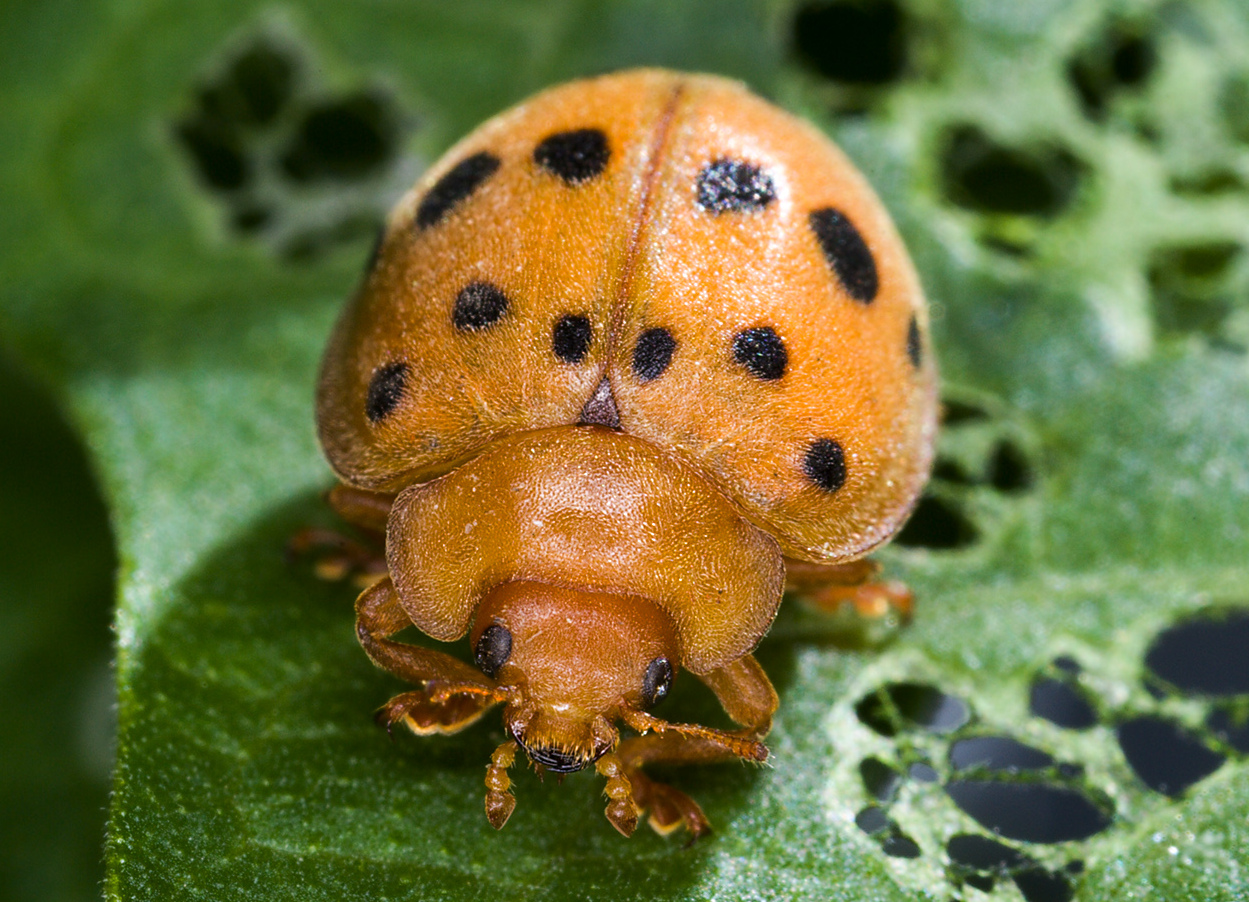Garden havoc can be caused by herbivorous insects. Various bugs and bothersome creatures create holes in the leaves and flowers of ornamental shrubs, annuals, and vegetable crops. These unpleasant critters, including caterpillars, slugs, snails, aphids, and beetles, can strip plant leaves, giving them a tattered lace-like appearance.
Understanding how to prevent bugs from devouring plants is vital knowledge for any gardener. Equally important is the ability to identify plant-eating insects to effectively control them. This allows you to learn about their habits and behavior, ensuring that garden bugs don’t become an unmanageable nuisance.
One challenge in identifying plant-eating bugs is that the holes they create seem to appear out of thin air. Some leaf-munching pests only feed at night, escaping detection through their destructive activities. Other insects, such as certain caterpillars, possess exceptional camouflage, making it difficult to spot and eliminate them.
Certainly, identifying plant-eating bugs in the garden is crucial to rule out the possibility of fungal or bacterial foliar diseases.
This article presents 11 common garden bugs and insects that consume plants, offering pictures of these plant-munching creatures and providing helpful tips for eradicating them from your garden.
Bugs that Eat Plants vs. Insects
While people often refer to all plant-consuming pests as bugs, not all plant-eating insects belong to the scientific order Hemiptera, which classifies true bugs. True bugs possess piercing mouthparts used to extract plant sap. However, not all plant-eating insects cause damage by sucking sap.
Plant-eating insects in the Hemiptera order include aphids, stink bugs, mealybugs, and scale insects. Other destructive insects that are not categorized as true bugs encompass beetles, slugs, snails, caterpillars, and earwigs.
Nonetheless, it is common to refer to any creepy crawly that harms plants as a bug. Furthermore, some dictionaries loosely define a bug as “any insect or insect-like invertebrate.” Consequently, this article refers to all insects causing plant damage in gardens as bugs.
Plant-Eating Bugs in the Garden — Identification, Pictures, and Control
Numerous types of bugs feast on plants and can be found crawling on your garden plants. These insects harm plants by chewing holes in leaves, nibbling on flowers, or extracting vital nutrients. Now, let’s explore in detail 11 types of bugs that you definitely don’t want to encounter in your garden.
Devourers of Plant Leaves: Slugs
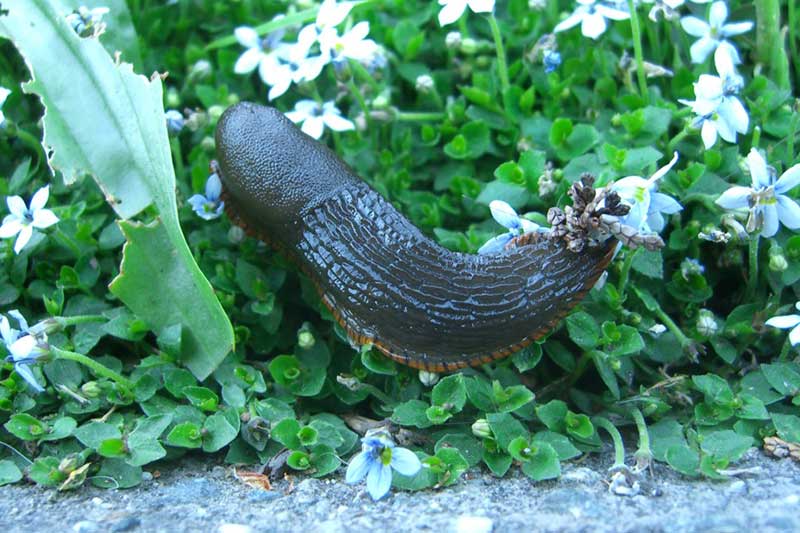
Slugs are troublesome pests that voraciously consume plant foliage.
When it comes to plant leaf consumption, slugs are among the worst culprits in the garden. These agricultural pests are characterized by their soft, slimy bodies. Slugs possess soft tentacles, a ribbed appearance, and leave behind a trail of slime. They tend to emerge after rainfall and seek refuge in dark, damp areas during dry weather.
Depending on the species, slugs can be elongated and slender with a tapered tail, or they can be stout gastropods with a relatively plump appearance. Garden slugs typically measure between 0.25″ (6 mm) and 2″ (50 mm) in length. Most plant-eating slugs are brownish or grayish, although some may appear jet-black.
Slugs are most active from spring through late summer. They consume leaves from various types of plants, including seeds, fruits, and vegetables. Their excessive feeding can weaken plants.
Identifying Plant-Eating Slugs
Identifying slugs is relatively easy due to their soft, slimy bodies. Slugs possess two tentacles, a mouth, and a breathing pore on their sides.
Additionally, they have a smooth underside. Evidence of slugs in your garden can be found in the form of slime trails on driveways and paths.
Signs of Slug Damage
When slugs feed on plants, they create chewed holes in leaves and flowers, leaving them with ragged edges. The damaged leaves often exhibit scalloped edges, and larger slugs can devour entire leaves. Bulbous and tuberous plants are also vulnerable to slug attacks, with these voracious pests causing holes in roots and bulbs.
Controlling Plant-Eating Slugs
An effective chemical-free method to eliminate slugs is by using beer traps. To create a slug trap, place a small bowl filled with beer in strategic locations throughout your garden. The yeast in the beer attracts slugs, causing them to climb into the bowl and drown.
Do beer traps work for slugs? A study published in the journal Crop Protection found that beer traps were equally as effective as commercial slug traps.
Discover other natural approaches to eliminating slugs from your garden.
Consumers of Plant Leaves: Caterpillars
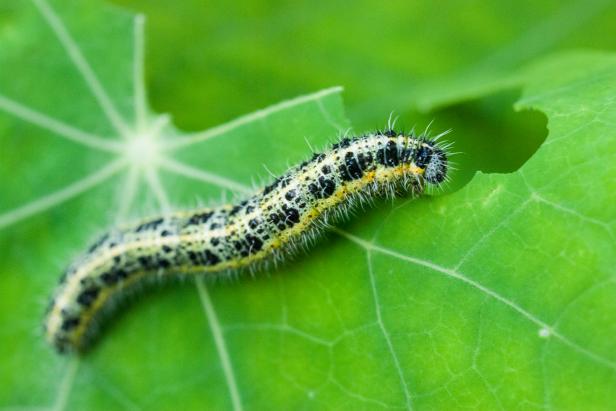
A monarch caterpillar feasting on a leaf.
Caterpillars, worm-like insects with insatiable appetites for plant leaves, are a common nuisance. Compared to other plant-eating insects, caterpillars are relatively easy to identify due to their soft, cylindrical bodies. These creepy crawlies can be hairy, smooth, or covered in poisonous spines, and they come in various colors.
To identify caterpillars, observe their size, color, specific markings (such as stripes or spots), and whether they are hairy. For example, stinging caterpillars typically possess bodies covered in spines or fine setae. Other caterpillar-like insects include horned caterpillars, which feature distinctive fleshy horn-like spikes at both ends.
Caterpillars that feast on plants include tomato hornworms, inchworms, cutworms, cabbage worms, and bagworms.
Identifying Plant-Eating Caterpillars
To identify a specific caterpillar species, look for distinguishing features. These may include head horns, spines, a curled or split tail, or a rounded head and tail. Additionally, consider the size of the caterpillar, as some plant-eating species are large, green bugs with disproportionately large heads.
Signs of Caterpillar Leaf Damage
Typical signs of caterpillar damage include chewed leaf edges, holes in leaves, or entire leaves missing from plants. Silky strands of web-like structures on plants may also indicate caterpillar activity. These voracious plant eaters can swiftly defoliate entire plants.
Controlling Plant-Eating Caterpillars
The most effective way to eliminate plant-eating caterpillars is to manually pick them off plants and place them in soapy water to kill them. Introducing beneficial insects that feed on caterpillar eggs and immature caterpillars, such as lacewings or parasitic wasps, can also help control their population and prevent plant damage.
Leaf Devourers: Snails
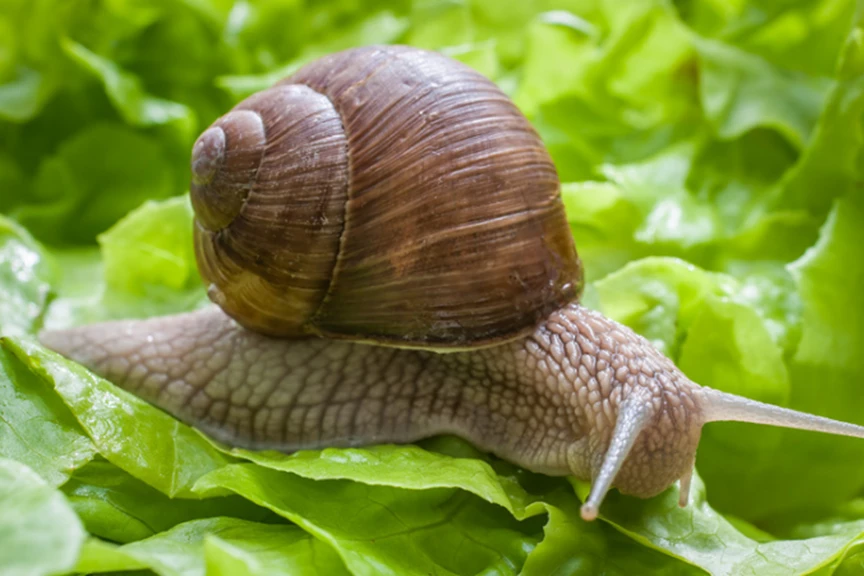
Snails, although not insects or true bugs, are gastropods that consume plants and can cause significant damage in gardens.
Snails are small, soft-bodied gastropods that feed on plant leaves, roots, flowers, and stems. Despite their slow-moving nature, snails can inflict severe harm on plants by using their tiny mouths to chew through plant tissues. These shell-bearing creatures typically consume tender, leafy foliage. Similar to slugs, snails leave behind a trail of mucus and slime.
Garden snails are notorious for being one of the most destructive pests, as virtually no type of plant foliage is safe from their feeding habits. They can devastate turfgrass seedlings, herbaceous plants, ripening fruits, tubers, and bulbous plants. However, they tend to avoid plants with strongly scented leaves or those with hairy, waxy, or glossy foliage.
Identifying Plant-Eating Snails
Snails are easily identified by their coiled shells atop their fat, slimy, worm-like bodies. They possess two tentacles, a mouth filled with thousands of teeth for devouring plants, and a mucus-producing underside.
Signs of Snail Leaf Damage
Classic signs of snail damage include large, ragged holes in leaves and the presence of slime trails on chewed leaves. These destructive, slimy pests can consume entire leaves and destroy seedlings.
Controlling Plant-Eating Snails
To deter snails from eating your plants, beer traps are an effective method. Additionally, similar to caterpillars, manually picking snails off plants and placing them in soapy water can help control their population.
Japanese Beetles (Popillia japonica)

Skeletonized leaves are a common sight when Japanese beetles feed on plants.
Japanese beetles are scarab beetles that feed on plant foliage by consuming leaves. These beetles stand out due to their brightly colored, metallic green bodies, often accompanied by bronze or golden-copper hues. Japanese beetles measure approximately 0.6″ (15 mm) in length and 0.4″ (10 mm) in width. Along their midsection, you’ll notice five distinctive white tufts.
Japanese beetles consume leaves from a variety of plants, including roses, various deciduous trees, azaleas, plants in the pea family, and hibiscus shrubs.
Identifying Japanese Beetles
Japanese beetles can be identified by their hard, iridescent green and coppery-bronze wing covers.
Signs of Japanese Beetle Leaf Damage
Japanese beetle damage on plants typically manifests as skeletonized leaves. These small, bronze and green bugs feed only between the veins of leaves, resulting in a lace-like appearance.
Japanese beetle grubs reside in the soil beneath turfgrass and shrubs. These plump, white, C-shaped larvae feed on roots, often causing foliage to wither or patches of brown grass.
Controlling Japanese Beetles
Inspect plants during mid-summer for signs of bug activity to effectively eliminate Japanese beetles. Handpicking the beetles and dropping them into a bucket of hot, soapy water is an efficient control method. Further strategies for eradicating these plant-eating beetles can be found elsewhere.
Cucumber Beetles
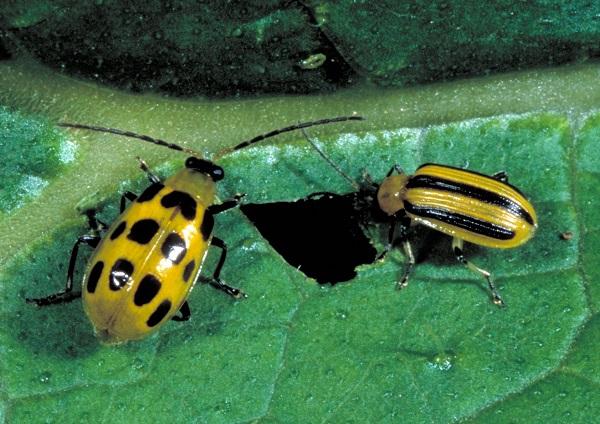
Spotted cucumber beetle (Diabrotica undecimpunctata) on the left, and striped cucumber beetle (Acalymma vittatum) on the right.
Cucumber beetles are small, yellow beetles adorned with black spots or stripes. These yellow bugs feed on plant leaves, shoots, and flowers of crops in the cucurbit family, such as cucumbers, squash, pumpkins, zucchini, and watermelons. They possess a black head, two antennae, and six legs.
Identifying Cucumber Beetles
Cucumber beetles are easily recognizable due to their vibrant yellow wing covers (elytra), yellow abdomens, and small size. Spotted cucumber beetles display 12 black spots on their bright yellow backs, accompanied by a greenish thorax. Striped cucumber beetles feature three black bands along their yellow backs and a yellow thorax.
Signs of Cucumber Beetle Leaf Damage
The most common sign of adult cucumber beetle damage is large, ragged holes in leaves. However, these yellow insects can also harm small plants and transmit foliar diseases that cause bacterial wilt.
Controlling Cucumber Beetles
To eliminate immature beetles in spring, you can utilize a homemade neem oil spray. Simply mix 2 teaspoons of neem oil, 1 teaspoon of liquid Castile soap, and 1 quart (1 liter) of water in a spray bottle. Shake the mixture thoroughly and spray it on foliage in the evening. Repeat this process weekly to eradicate these plant-eating beetles. More control methods for cucumber beetles can be found elsewhere.
Aphids

Aphids on plants are small crawling insects with various colors depending on the species, some developing a waxy or woolly coating.
Aphids are highly destructive bugs that feed on the sap of garden plants. These tiny pests hide underneath foliage as they cause damage. Aphid infestations result in stunted plant growth, wilted leaves, and leaf drop. In severe cases, aphids can even kill various types of plants in front or backyard settings.
Aphids have pear-shaped bodies measuring less than 0.23″ (6 mm) in length. However, some species can be as small as 0.07″ (2 mm). Aphids tend to congregate in large groups, making it easy to identify infestations. Depending on their color, aphids may be referred to as greenfly, whitefly, or blackfly.
Identifying Aphids
Aphids can be recognized by their tiny, tear-shaped bodies with long legs and two protruding tail-like structures at the rear. Some aphids may have a white, fuzzy coating, known as woolly aphids.
Signs of Aphid Leaf Damage
Aphids cause damage to plants, resulting in stunted growth, yellowing and crinkling of leaves, and leaf curling. They leave behind honeydew, a yellow, sticky substance on plants. Additionally, the presence of black sooty mold on leaves is another indication of aphid damage.
Controlling Aphids
The easiest way to eliminate aphids that destroy plants is by using a hose. Use a strong jet of water with enough pressure to dislodge the pests without harming the foliage. Thoroughly spray both sides of the plant leaves.
Colorado Potato Beetle
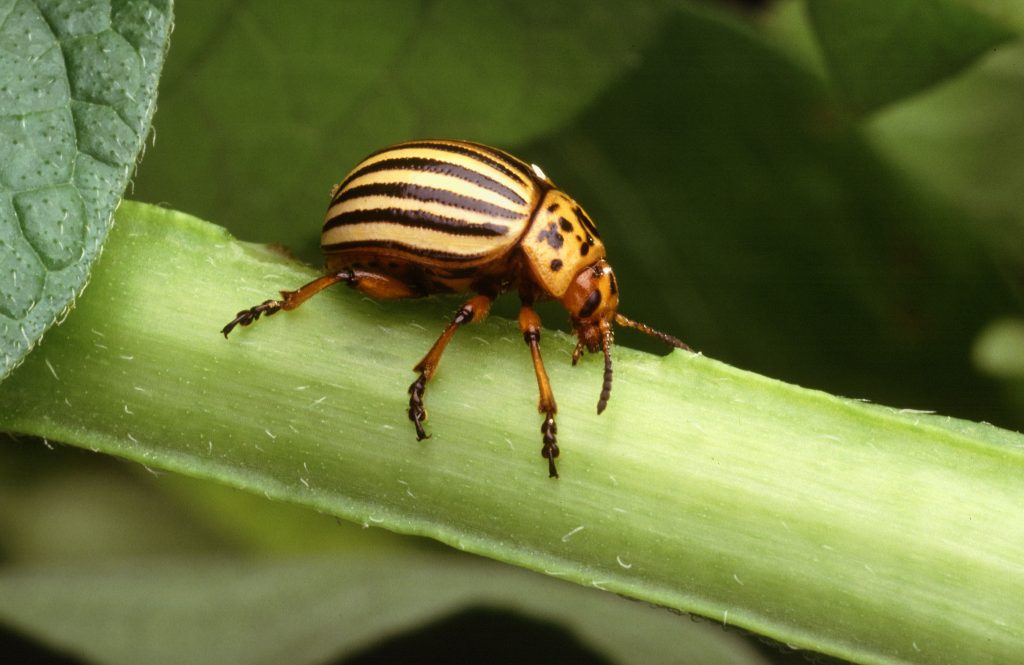
The Colorado potato beetle (Leptinotarsa decemlineata) not only feeds on potato crops but also attacks other plants in the nightshade family.
The Colorado potato beetle is a striped beetle that consumes the leaves of potato plants. This beetle showcases orange and black lines on its back. It has a small, rounded body with an orange and black thorax, clubbed antennae, and orange legs.
A distinctive feature of this plant-eating beetle is its rounded body adorned with prominent stripes. The beetle measures between 0.24″ and 0.43″ (6-11 mm) in length. It primarily targets plants in the nightshade family, particularly potatoes.
Identifying Colorado Potato Beetles
Colorado potato beetles are small leaf beetles with easily recognizable pale black and orange-beige stripes. They possess black markings on their flattened orange heads and two segmented antennae.
Signs of Colorado Potato Beetle Leaf Damage
The most common sign of Colorado potato beetle infestation is leaf defoliation. Leaves may exhibit ragged edges, and dark frass can be found on the foliage. The adult beetles, featuring yellow or orange bodies with black stripes, feed on the leaves and stems of potato crops.
Controlling Colorado Potato Beetles
The most effective method of controlling Colorado potato beetles is by manually picking the adult beetles off plants and destroying their yellowish-orange eggs found on the underside of foliage.
Grasshoppers

Grasshoppers are plant-eating bugs typically green or brown in color, varying in size based on the species.
Grasshoppers are destructive insects that feed on plants, rapidly decimating vegetation. These bugs can be green or brown, possessing large hind legs, a face angled vertically to their bodies, and stubby antennae. Grasshopper species range in size from a few millimeters to over 3″ (75 mm) in length for larger leaf-feeding insects.
Identifying Grasshoppers
Grasshoppers that feed on plants are easily identifiable. They are typically slender with green or brown bodies, while some exhibit multicolored or mottled patterns.
Signs of Grasshopper Leaf Damage
Signs of grasshopper damage on plants include large holes, ragged holes with bite marks, and defoliated vegetation, particularly in the case of locusts.
Controlling Grasshoppers
According to Colorado State University, grasshopper infestations are challenging to control. The best approach is to prevent eggs from hatching. Tilling the soil in late fall and early spring to destroy any eggs present in the ground is a recommended practice. Further control methods for grasshoppers can be found elsewhere.
Squash Bugs
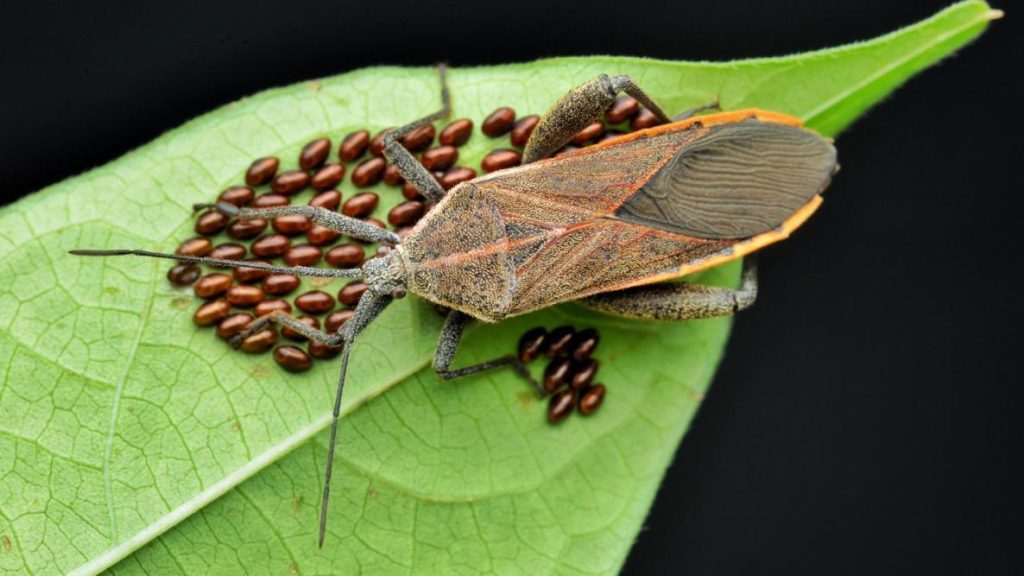
Squash bugs (Anasa tristis) mainly damage pumpkin and squash plants by sucking sap from the leaves.
Squash bugs are insects that extract sap from plant leaves, causing damage. These brown-colored bugs possess flat backs and bodies adorned with tan-colored speckles. They measure around 0.6″ (15 mm) in length. When disturbed or crushed, squash bugs emit a foul odor.
Squash bugs inflict considerable harm on plants, causing wilting and death of leaves. They are often found infesting squash plants, which is why they acquired their common name.
Identifying Squash Bugs
Squash bugs are identified by their dark gray or brown flat backs, elongated oval bodies with spotted markings, and triangular patterns.
Signs of Squash Bug Leaf Damage
Signs of squash bug damage include yellow spots on squash and pumpkin leaves. Severe infestations can cause leaves to turn yellow, wilt, and die.
Controlling Squash Bugs
The most natural method for eradicating squash bugs is to manually remove adults and nymphs from leaves and submerge them in soapy water to kill them. In the case of a cluster of bugs on a squash plant leaf, removing the entire leaf and disposing of it in soapy water is recommended.
Mexican Bean Beetle
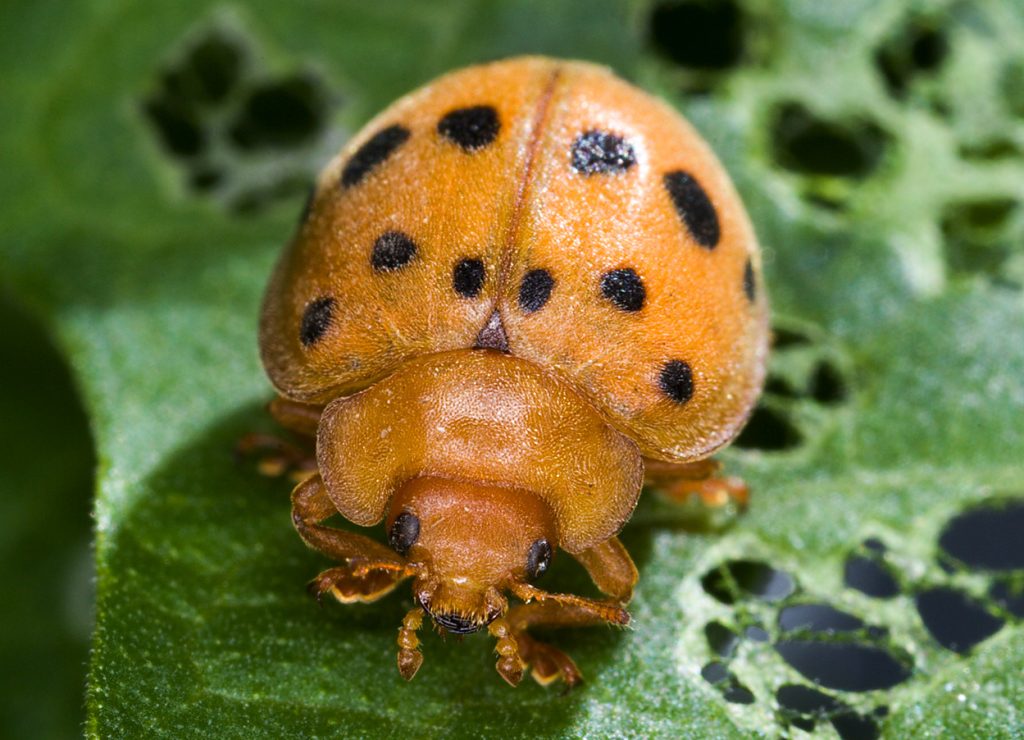
The small orange Mexican bean beetle (Epilachna varivestis) is covered in black spots and feeds on bean plants.
Mexican bean beetles consume plant foliage, leaving the leaves skeletonized. These tiny orange beetles possess rounded, oval wing covers adorned with jet-black spots. The beetle’s head, thorax, and two clubbed antennae are orange in color. This beetle, measuring between 0.23″ and 0.27″ (6-7 mm), belongs to the ladybug family.
Mexican bean beetles are commonly found feeding on flowers and seed pods of plants in the pea family (Fabaceae). They cause damage by destroying leaves, resulting in a wilted lace-like appearance. These beetles can appear orange, yellow, or red.
Identifying Mexican Bean Beetles
Mexican bean beetles have a characteristic round shape with a bright orange back adorned with black spots.
Signs of Mexican Bean Beetle Leaf Damage
Mexican bean beetle damage is evident when these small orange and black beetles consume plant tissue between leaf veins, causing the leaves to appear transparent or skeletonized. Adult beetles may also damage flowers, bean pods, and stems.
Controlling Mexican Bean Beetles
The most effective method of controlling Mexican bean beetles is to manually remove egg clusters and larvae
by hand. In severe infestations, the use of Spinosad, a natural pesticide, can be considered.
Tarnished Plant Bug
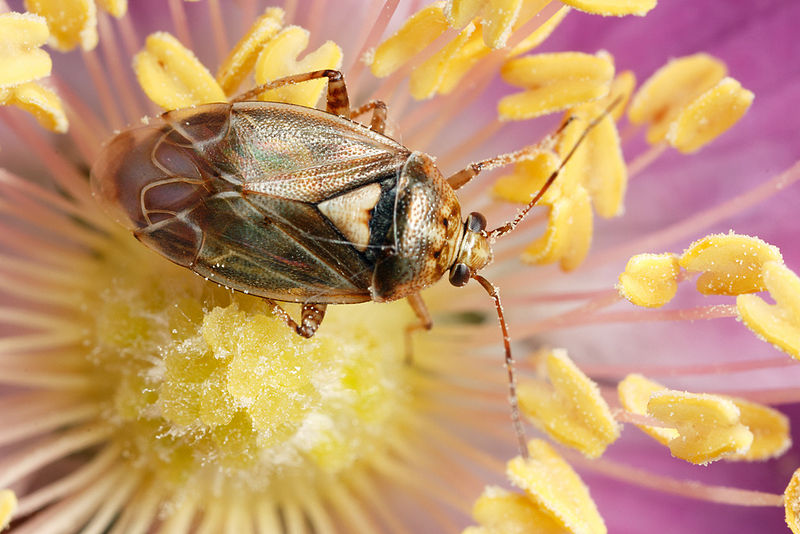
Tarnished plant bugs (Lygus lineolaris) damage flower buds.
Tarnished plant bugs are brownish insects that feed on plant buds, particularly those of developing fruits. These bugs have pear-shaped bodies with dark and pale brown markings, brown-banded legs, and antennae. They cause damage to plants by injecting saliva through their sucking mouthparts. These bugs affect many bean plants, crops, and ornamental shrubs.
Identifying Tarnished Plant Bugs
Tarnished plant bugs can be identified by their brown bodies and brown legs.
Signs of Tarnished Plant Bug Leaf Damage
Signs of leaf damage caused by tarnished plant bugs include damaged flower buds that drop prematurely, blooms that fail to open, deformed leaves, as well as scarred and discolored leaf petioles or stems.
Controlling Tarnished Plant Bugs
If you suspect tarnished plant bugs are feeding on plants in your garden, spraying them with a garden hose can help dislodge these tiny insects from the foliage. A short, sharp blast of water is usually enough to remove them.
These are just a few examples of plant-eating bugs and insects that can cause damage to your garden. By identifying these pests and implementing effective control measures, you can protect your plants and ensure a thriving garden.
